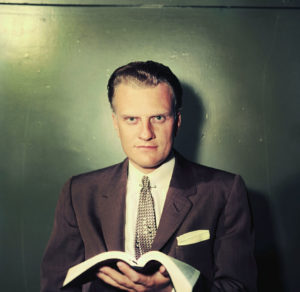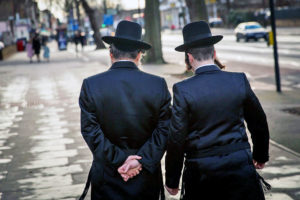The leafy, residential streets of Cambridge are about as far as you can get from the arid valleys of Utah. But with its grey concrete spire and squat mid-century gabled exterior, the chapel in the suburb of Cherry Hinton could have been transplanted directly from Salt Lake City. It is a striking sign of a little-known fact: that the Mormons are a force to be reckoned with in East Anglia.
The Utah-based religious movement — founded in 1830 in New York State — rebranded in 2018, calling for “Mormon” to be abandoned in favour of the official “Church of Jesus Christ of Latter-day Saints”. “It’s a bit of a mouthful,” admits Kevin Johnson, 56, who was raised in the faith in Norwich and now worships in Cambridge. But the focus on “latter days” is strategic: “we’re here now to make a difference in the world”. And for that, the Church needs funds.
On the other side of Cambridgeshire, it is doing God’s work, in the fertile earth of the fens. In the village of Woodwalton, near Huntingdon, it owns thousands of acres. Over the years, it has been variously reported to be the largest foreign purchaser of land in Britain; during a spree in the late Nineties, it spent £30 million on prime farmland in the space of six years. More recently, it came top of Farmers Weekly’s list of “unusual owners of UK farmland”. According to Guy Shrubsole, author of Who Owns England?, the Church is the 78th largest landowner in the country, with 7,716 acres.
Agriculture may seem like a surprising sideline, but it is in keeping with the Church’s history — the pioneers of Mormonism, Joseph Smith and Brigham Young, were both sons of farmers — and its central values. There is “an emphasis on self-reliance”, says Anne Thomas, a 27-year-old Latter Day Saint from California who just completed her PhD at the University of Cambridge — “just being prepared for anything”.
The Church’s control of land is usually indirect. It effectively runs a multinational firm named AgReserves, which was once reported to be America’s largest producer of nuts and is the largest private landowner in Florida — where it is planning a city almost 20 times the size of Manhattan. A subsidiary of the firm, Farmland Reserve UK Ltd, exists in this country as both a registered charity and a limited company, according to documents lodged at Companies House. Its principal activity is arable farming, and it has been reaping the rewards of soaring global cereal prices. It owns land worth almost £54 million and buildings worth almost £17 million.
While their religious activities — which include handing out literature on the street — are highly visible, their business enterprises are not. The church was quick to tell me that while its community members would be happy to be interviewed, “the farmland entity” would not.
It was not always so media-shy. Back in 1999, The Independent was invited into its boardroom on Manor Farm. A printed sign read: “Our business is farmland. Profit motivated: No Excuses.” In the Nineties, it was expanding — into Norfolk, Suffolk and Lincolnshire. Now, it is going into retreat. Accepting that the “scattered nature of some of the parcels of land do lead to some labour and equipment inefficiencies”, the company is consolidating its land holdings “around one major farm centre in Cambridgeshire”.
But the strategy is still paying dividends — turning some of Britain’s most high-grade land into hard cash. Last year, the company donated £2 million to its Utah sister charity, which spent £1 million on renovations to the two UK temples (in Surrey and Lancashire) and £1 million on vaccinations in Slovakia, Albania and Bulgaria, wheelchairs in Cape Verde, and support for Afghan refugees in Germany.
These donations sound heavenly, but the Church has faced allegations that it is trying to make itself appear more generous than it actually is. Just last month, it was accused of overstating the amount it gives in charity by more than $1 billion. Members are required to “tithe”, or donate, 10% of their income to the Church. But The Sydney Morning Herald reported that the Church then donates less than 1% of what it receives to charity, and stockpiles cash and investments in a $100 billion tax-free fund. In 2020, Roger Clarke, the head of the “Ensign Peak” fund, told The Wall Street Journal that knowledge of it among members might discourage tithing, saying they “never wanted to be in a position where people felt like, you know, they shouldn’t make a contribution”.
“The Mormon church will have you believe that it’s a religion that dabbles in business,” says ex-Mormon Ryan McKnight, who founded MormonLeaks, “but the evidence clearly shows that they are a business dabbling in religion.” A Utah spokesman denied the charge, saying: “The Church of Jesus Christ is not a financial or profit-making institution and uses its resources to carry out its divinely appointed mission.”
No multi-billion-dollar fund, however, can stop people asking difficult questions. And the Church has been having to adapt to head off criticism of the stickier parts of its history. Polygamy was dropped in 1890 (although a man can still be “sealed” to more than one woman in the afterlife). A ban on black men joining the priesthood was not lifted until 1978. (It remains for women of any colour.) And it took until 2014 for the Church to officially admit for the first time that Joseph Smith had up to 40 wives, including a 14-year-old girl.
Meanwhile, disciples are coming from the most unlikely of places. The Book of Mormon musical — which mercilessly satirises the religion — arrived in the West End in 2013 and began touring the UK in 2019. Church missionaries often proselytise after performances – with some audience members mistaking them for the cast and others even joining the Church after having their interest piqued. It seems a uniquely Latter Day Saint reaction to lampooning. “I think we kind of roll with it,” says Anne Thomas. “Because we are a pretty small population, we want to be on good terms with people that don’t know a lot about the Church. We want to have a positive interaction rather than a defensive one.” As adverts in the show’s programme, funded by the Church, say: “You’ve seen the play… now read the book.”
In the second half of the 20th century, it was not just land that the Church was acquiring, but members — at a rate of knots. Sociologist Rodney Stark forecast in 1984 that what was then Mormonism would become the first new major world religion since Islam. However, today, while growth is strong in Africa, it is having problems elsewhere. In 2011, Elder Marlin Jensen accepted that members in the US were “leaving in droves” in a “period of apostasy”. And the Church has failed to take flight in Britain in recent decades. It grew from 6,500 members in the mid-Sixties, to almost 200,000 in the Nineties (in 1995, The Spectator even predicted that “it may not be long before there are more Mormons going to church in England than Anglicans”). But UK membership now stands at 186,803, a figure that has remained virtually static for more than 20 years. Numbers of new recruits have been falling: in 2017, it baptised 1,494 proselytes. This fell to 1,281 in 2018; 995 in 2019; and 454 in 2020. The Church spent £7.8 million on its missionary programme last year, which resulted in the baptism of 655 converts.
But that is only one measure of progress; growth can also come from beyond the grave. The Church claims to have amassed the largest collection of family records in the world and all (living) members are encouraged to “take an Ancestor to the Temple”, a tenet of their faith that makes for perennial headlines. In 1995, in 2012, and again in 2017, the Church had to apologise for posthumously baptising Jewish victims of the Holocaust. Winston Churchill, Marilyn Monroe and the Queen Mother have all reportedly been converted in the afterlife. Anna McKeown, who studied at Brigham Young University in Utah before moving to Cambridge, says: “We believe, over the next thousand or so years, that we’ll hopefully be able to do that for everyone.”
Quarrying the past is central to the faith. But the Latter Day Saints should perhaps be more concerned with sowing seeds for the future. It costs nothing but controversy to convert the dead — and, if its stance towards the Book of Mormon is anything to go by, the Church can see all publicity is good publicity. Converting the living, though, is expensive. It is as much in the Fens’ fruitful farmland as in their family records database where the Latter Day Saints will be digging for divine victory.
***
Order your copy of UnHerd’s first print edition here.
Disclaimer
Some of the posts we share are controversial and we do not necessarily agree with them in the whole extend. Sometimes we agree with the content or part of it but we do not agree with the narration or language. Nevertheless we find them somehow interesting, valuable and/or informative or we share them, because we strongly believe in freedom of speech, free press and journalism. We strongly encourage you to have a critical approach to all the content, do your own research and analysis to build your own opinion.
We would be glad to have your feedback.
Source: UnHerd Read the original article here: https://unherd.com/





